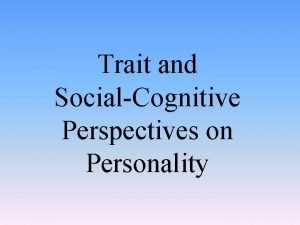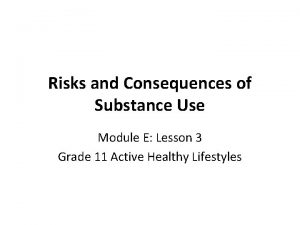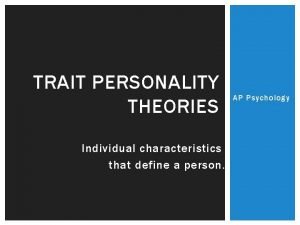Personality factors 1 2 3 Personality factors Selfesteem










- Slides: 10

Personality factors 1

2. 3 Personality factors Self-esteem the extent to which an individual believes himself to be ‘capable, significant, successful and worthy’ desire to be liked and appreciated dependent on positive or negative experiences and on how smbd is viewed by significant others traditional school setting often fail to provide positive feedback global - the general belief in one’s capacities situational - in language learning, belief in one’s capacity to learn a foreign language specific - belief in one’s capacity to speak or write in a foreign language students with higher self-esteem can learn languages more easily Low self-esteem manifested in different ways: some seem to be shy, fearful or unwilling to speak, others could bully or brag – consequently they avoid the activity

should the teacher make an effort to raise the self-esteem of the students or to raise their level of proficiency which would lead to their higher self-esteem? Self esteem consists of: a sense of security, a sense of identity, a sense of belonging, a sense of purpose & a sense of competence students’ self-esteem can be enhanced by: giving more attention to their achievements and not to their failure creating the most positive learning environment that offers support and encouragement designing learning objectives according to students’ abilities, which means selecting adequately challenging tasks

Inhibition a way of building defences that can protect personal beliefs and values from threats coming from the outside world a person with high self-esteem is less likely to be inhibited Inhibition makes language learning more difficult learning a foreign language necessarily involves making mistakes which can lead to a deep-seated fear of inadequacy or deficiency and to unwillingness to ‘take risks’ and get involved in communication lowering inhibition – necessary, achieved by: providing good learning conditions where learners’ errors are treated as a normal stage in their proficiency development encouraging self-monitoring and self- correction focusing on students' strengths rather than weaknesses

To lower inhibition, teachers should refrain from: labelling, criticism, sarcasm, comparisons and evaluating the person rather than the behaviour

Anxiety is a vague feeling of worry, nervousness or tension related to success in future activities and tasks the worry and negative emotional reaction aroused when learning or using a second language distinct complex of self-perceptions, beliefs, feelings, and behaviours related to classroom language learning arising from the uniqueness of the language learning process global, situational and specific debilitative - a feeling of nervousness that is strong enough to prevent a person from fully expressing his or her potentials facilitative -‘creative’ nervousness that keeps a person alert and tense to the extent needed to activate potential (low anxiety state)

Major sources (Young; 1991) : (1) personal and interpersonal anxieties, (2) learner beliefs about language learning, (3) instructor beliefs about language teaching, (4) instructor-learner interactions, (5) classroom procedures and (6) language testing.

Horwitz, Horwitz and Cope (1986) - three crucial sources: communication apprehension - a type of shyness characterized by a fear of or anxiety about communicating with people test anxiety - a type of performance anxiety stemming from a fear of failure (often unrealistic expectations) fear of negative evaluation - a learner’s need to avoid making a negative social impression on others To reduce anxiety: creating a positive atmosphere carefully correcting errors selecting tasks that are well-known to be low-anxiety provoking (not – calling on students randomly) introducing structured and semi-structured activities first (safer)

Risk-taking necessary in successful language learning (much guessing; errors often occur) people who achieve a lot are often moderate risk-takers a successful learner makes a calculated guess and takes a moderate ’risk’ of being corrected or misunderstood high risk takers - producing meaningless utterances, dominating the classroom low risk takers – prefer to be silent and passive avoid to speak in the classroom get insufficient practice and feedback tend to ’fossilize’ earlier (fossilization – a permanent incorporation of certain patterns of error) should be encouraged

Encouraging students: Setting realistic and adequately challenging goals Providing a safe and supportive atmosphere Treating errors unobtrusively Scaffolding Focusing on strengths and giving positive feedback (but not empty praising)
 Definition of selfesteem
Definition of selfesteem Selfesteem definition
Selfesteem definition Cattell's 16 personality factors
Cattell's 16 personality factors What factors affect personality
What factors affect personality Factors that determine your personality module e
Factors that determine your personality module e Allport cardinal traits
Allport cardinal traits Cattell's 16 personality factors
Cattell's 16 personality factors Cattell's 16 personality factors
Cattell's 16 personality factors Biotic vs abiotic factors
Biotic vs abiotic factors Abiotic factor
Abiotic factor Site factors vs situation factors
Site factors vs situation factors



















